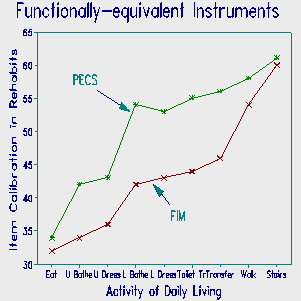
Fisher, Harvey & Kilgore (1995) report equating instruments with different rating scales and items. The instruments measure what practitioners perceive as the same "motor skills". The instruments' developers, however, each perceive their own instrument as significantly better than and hence "incompatible" with other instruments.
The instruments are the Patient Evaluation Conference System (PECS(c)) with 22 motor skill items, and the Functional Impairment Measure (FIM) with 13 motor skill items. The instruments are used to measure the capacities of patients in North American and European rehabilitation facilities to function independently, e.g., walking, eating, dressing, and bathing. Both instruments employ a 1-7 rating scale, where 1 is maximum dependence on others and 7 is independence within normal limits. But the instruments' rating scales differ:
1) PECS uses detailed descriptions of the behaviors associated with each rating category for each item. FIM uses a general description of the set of rating categories for each item.
2) The position of the step from mostly dependent to mostly independent differs. PECS positions this step between ratings of 4 and 5. FIM positions it between 5 and 6. So PECS has four ratings for dependent functioning and three for independent functioning, while FIM has five and two.
Many experts conclude that the differences between these instruments mean they measure different things and cannot be equated. To test this perception, ratings from both instruments were made of 54 rehabilitation hospital patients. These data were then fitted to a Rasch model which specified that PECS items shared one rating scale while FIM items shared another. The resulting 35-item scale had good summary statistics: person separation 4.5 (.95 reliability), item separation 6.8 (.98 reliability). The 35 items from PECS and FIM worked well together!
Item order and item fit statistics conformed to previously published analyses of much larger data sets from each instrument. The items were then anchored at the calibrations obtained from the combined analysis and separate analyses were performed to produce PECS and FIM measures for each patient. The raw correlation between these pairs of measures was .91, which, when disattenuated for measurement error, became .99!

The Figure plots the calibrations of nine items assessing areas common to PECS and FIM. The plot is scaled in a common interval unit, the "rehabit". It shows that it is more difficult to achieve a given rating of functional independence on the PECS than on the FIM. It also shows that, no matter which instrument is used, "eating" is easiest; "dealing with stairs" is hardest; upper extremity (U) activities are easier than lower extremity (L) ones; and transfers are more difficult than everything but walking and stairs. Despite many practical differences between PECS and FIM, the two instruments measure one construct, and their measures can be expressed in one common unit.
Fisher WP, Harvey RF, Kilgore KM (1995) Rehabits. Archives of Physical Med. & Rehab. 76(2):113-22 Feb.
Rehabits: Equivalent measures from different instruments. Fisher WP Jr. … Rasch Measurement Transactions, 1995, 9:1 p.420
| Forum | Rasch Measurement Forum to discuss any Rasch-related topic |
Go to Top of Page
Go to index of all Rasch Measurement Transactions
AERA members: Join the Rasch Measurement SIG and receive the printed version of RMT
Some back issues of RMT are available as bound volumes
Subscribe to Journal of Applied Measurement
Go to Institute for Objective Measurement Home Page. The Rasch Measurement SIG (AERA) thanks the Institute for Objective Measurement for inviting the publication of Rasch Measurement Transactions on the Institute's website, www.rasch.org.
| Coming Rasch-related Events | |
|---|---|
| Jan. 16 - Feb. 13, 2025, Fri.-Fri. | On-line workshop: Rasch Measurement - Core Topics (E. Smith, Winsteps), www.statistics.com |
| Apr. 8 - Apr. 11, 2026, Wed.-Sat. | National Council for Measurement in Education - Los Angeles, CA, ncme.org/events/2026-annual-meeting |
| Apr. 8 - Apr. 12, 2026, Wed.-Sun. | American Educational Research Association - Los Angeles, CA, www.aera.net/AERA2026 |
| May. 15 - June 12, 2026, Fri.-Fri. | On-line workshop: Rasch Measurement - Core Topics (E. Smith, Winsteps), www.statistics.com |
| June 19 - July 25, 2026, Fri.-Sat. | On-line workshop: Rasch Measurement - Further Topics (E. Smith, Winsteps), www.statistics.com |
The URL of this page is www.rasch.org/rmt/rmt91m.htm
Website: www.rasch.org/rmt/contents.htm